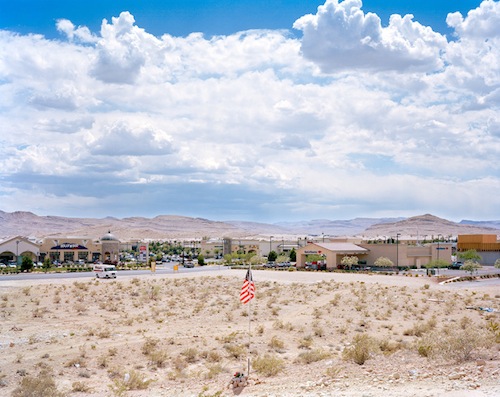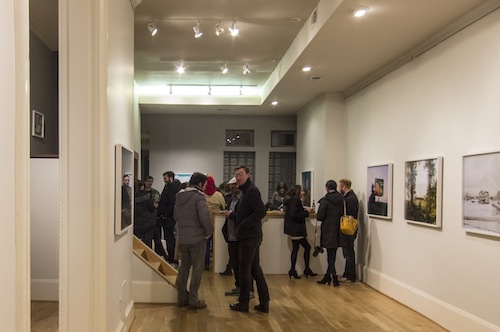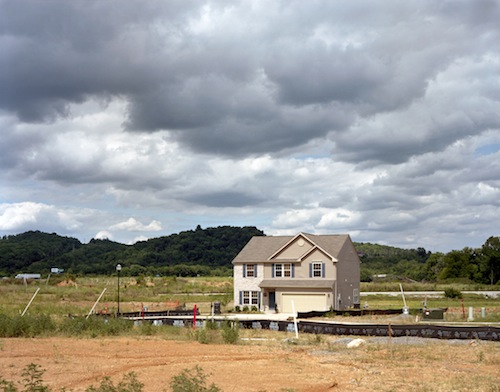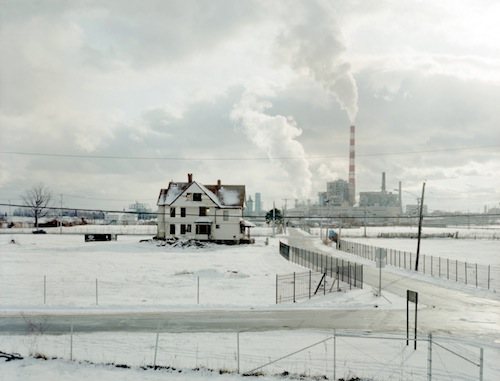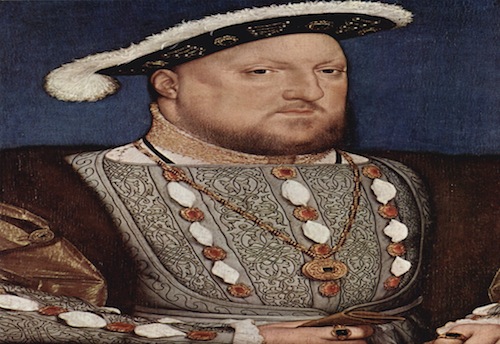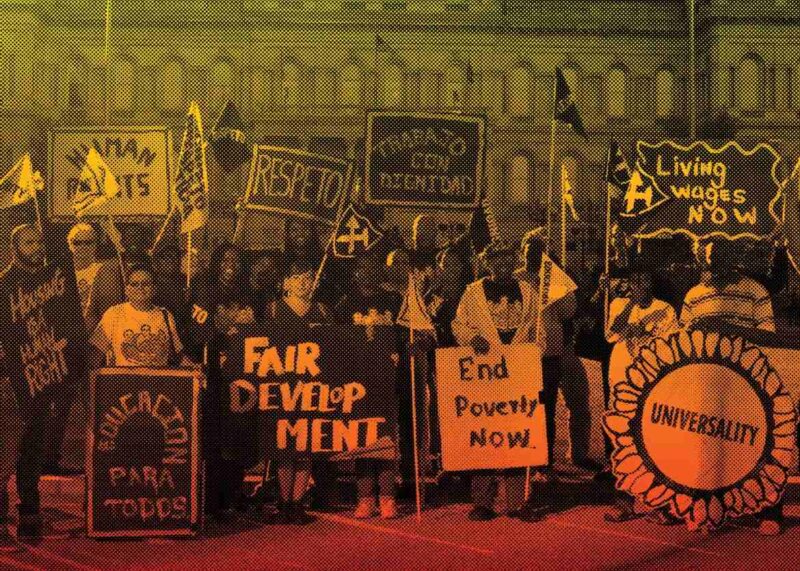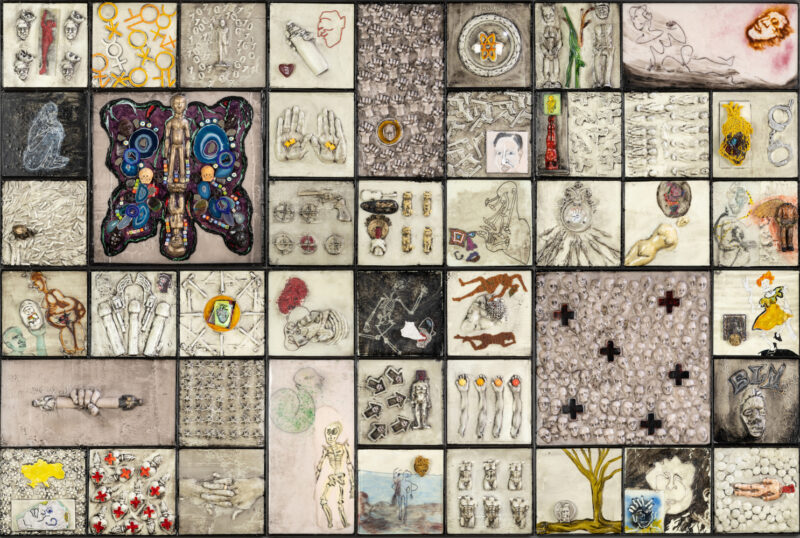Selected photographs from Carl Gunhouse’s book Falling Apart span six years of coast-to-coast photographic impulses. Now on display at Guest Spot at the Reinstitute, the work depicts strange changes occurring in Anyplace, USA, tied unsettlingly to the contemporary economic crisis and political climate. A few portraits, including a provocative image of Mexican children staring through a border protection fence, add a human face to the show, but for the most part the personality of the work lies in the idiosyncratic byproducts of consumerism in the developed wilderness, entangled in “a culture that is obsessed with access to excess.”
Gunhouse’s digital prints from large format negatives are elegantly framed, hanging several feet apart from one another around the gallery. This type of curation diffuses the series spatially and reinforces the decentralized pacing of the work, with individual images given adequate space to be contemplated. Each selection from the book allows the eye to revel in the range of rich, yet subtle color, detailed variety of texture, and pictorial strength of the images. In several of the photos, the sky, clouds, and quality of light are traditionally lovely, emphasized by large portions of the composition. The prettiness Gunhouse pursues makes the series visually compelling, and dilutes harsh criticism into an exploration of the effects of blatant commercialism.
At the opening of the show, Gunhouse told me about his process of building a series, and his awareness of the recent tradition of disillusioned American color photography, which includes Joel Sternfeld, Mitch Epstein, Richard Misrach, Joel Meyerowitz, Stephen Shore, and others. However, Gunhouse’s photographs stand out for their unique and delicate portrayal of the byproducts of economic and social trends in the sub-suburban American wilderness.
Some of the most characteristic images from Falling Apart are: an insipid, overwhelmingly empty suburban intersection, distant smoke-stacks looming over a snow-covered suburban wasteland, an outrageously decadent (unsold) mansion with it’s own miniature helicopter, a nearly blank Wal-Mart dominated mall signboard, an enormous McDonald’s lemonade billboard in the middle of a field, and a paved lot of stark-white Presidential bust sculptures (fore-fronted by the first non-white President, no less). Beyond his highly charged, absurd subjects, the most interesting aspect of the series is the consistent distraction and detritus in the landscape.
Gunhouse presents views centered on evident contradictions like the strip mall in the desert, or an overtly marginalized subject like the whitewashed presidential busts, but always reveals the minutia of the location from his large format vantage point. Distant oil tankers out at sea, winding fences, parked cars, cinder blocks, traffic cones, blurry leaves swaying in the breeze, automatic sprinkler heads, and scattered trash all distract from the main subjects, reinforcing the concept behind the entire series as much as the larger subjects do. Presenting a country where nothing is black-and-white, where scraps, dross, and complications appear in every photo, Gunhouse’s title Falling Apart evokes a passive chaos lying in the wake of the senseless consumer developments he photographs.
The landscape itself is at the mercy of an incessant culture of access to excess and a roller-coaster economy. Gunhouse insists that the work addresses the recession of the past few years, but I think the selected images hung in the exhibit defy such a prescription, reflecting something more profound and metaphorical about the country.
Departing from the great scope of the landscapes, several portraits and relatively intimate views of curious subjects punctuate the series. A woman in a bright orange sari sits in front of surreal white dunes. A used condom hangs delicately from leaves at a scenic overlook. These images don’t pull focus from the others; rather, they are an expanded sample of the perspective Gunhouse offers. They demonstrate that he not only photographs the bleak, he celebrates the unconventional humanity entangled in the bigger picture.
Haphazardly but harmlessly paired with Gunhouse’s work, Max Guy’s series Small Studies in Orientation hangs quietly, tongue-in-cheek in the rear room of the exhibit. Aside from being comprised of digital prints, this series is very different from Falling Apart. Each piece is a small framed print of a classical pastoral or portrait painting, compressed digitally into the obverse shape, either landscape or portrait rectangle orientation. The work toys with notions of viewing habits and learned sense of convention in art, pointing out viewers’ loaded tendencies to appreciate paintings of different shapes differently, whatever the subject. A portrait of Napoleon on horseback is compressed horizontally, emphasizing the width of the landscape behind him and reducing the Emperor to an even more diminutive stature. Guy curates an element of the ridiculous in the relatively dry work with the inclusion of a blue banana, placed discretely at random locations around the walls of the bare room. Most visitors at the opening didn’t notice the fruit until Max or their friends pointed it out, but after that it was impossible for anyone to ignore.
Carl Gunhouse will give an artist talk at the Reinstitute from 2-4PM on March 23, the closing date of this Guest Spot exhibit. http://guestspot.org/
Author Mac Falby studies photography and humanities at the Maryland Institute College of Art, class of 2014.
